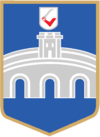European Avenue
| <span class="nickname" ">Europska avenija | |
|
| |
| Former name(s) |
Chavrakova ulica (1904-1919) Aleksandrova ulica (1919-1941) Ulica Ante Starčevića (1941-1946) Bulevar generalissimusa Staljina (1946-1948) Bulevar Jugoslavenske narodne armije (1948-1991) Europska avenija (1993-present) |
|---|---|
| Location | Osijek, Croatia |
| East | Duke Trpimir Street |
| West | Stjepan Radić Street |
European Avenue (Croatian: Europska avenija) is a street in Osijek, Croatia. It is the most representative street in Osijek, because, from west, first part of street contains strings of secession buildings.
History
By the end of 19th century this street was extension of Kapucinska Street, with only few buildings on southern side of street.
In 1894 in historicist style was built Palace of Croatian Chamber of Economy.
In 1897 in Italian renaissance style was built Neumann building, today building of Gallery of Fine Arts.
From 1904 to 1906 on northern side of street were built strings of secession buildings. Street was called Chavrakova Street (Croatian: Chavrakova ulica).
In 1919 street was renamed to Aleksandrova Street (Croatian: Aleksandrova ulica). It was called after then Yugoslav king Alexander.
In 1941 street was renamed to Ante Starčević Street (Croatian: Ulica Ante Starčevića). It was called after Croatian politician Ante Starčević.
In 1946 street was renamed to Boulevard of generalissimo Stalin (Croatian: Bulevar generalissimusa Staljina). It was called after Soviet dictator Joseph Stalin.
In 1948 street was renamed to Boulevard of Yugoslav People's Army (Croatian: Bulevar Jugoslavenske narodne armije). It was called after Yugoslav People's Army.
In 1993 street was renamed to European Avenue.
